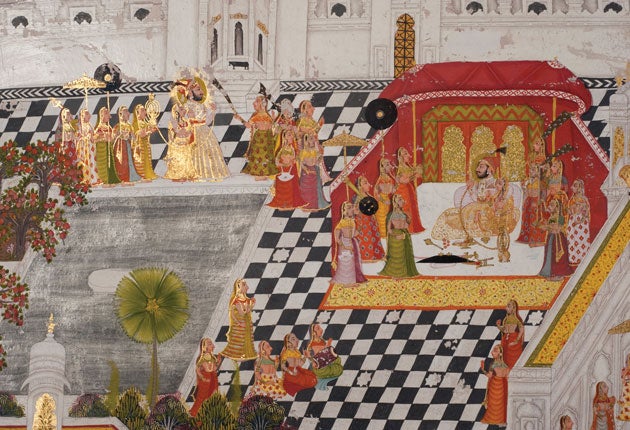Maharaja: The Splendour of India's Royal Courts, Victoria and Albert Museum, London
A taste for luxury was not merely a perk but a duty for Indian kings, patrons of artists and craftsmen

Try it on your tongue and it's a procession of long, drawling syllables. Maharaja. The word contains the stateliness and grandeur of India's courtly past and, like Versailles, triggers associations of limitless opulence.
So it's no surprise that the Victoria and Albert Museum's show of that name is a parade of dazzling colours and textures, brimming with jewels, ivory, fabrics and fine paintings.
What is surprising is the representation of the maharajas themselves. You might have thought these feudal kings ruled the masses from the distance of their marbled palaces, lolling on couches to be fanned by an army of bowing punkah wallahs. But what the curators have tried to do – and successfully – is show the maharajas as men of duty and honour who did a lot for the greater cultural good of India.
Maharajas, meaning "great kings", lived by a code called rajadharma, meaning "the way in which a king should comport himself to be righteous". All citizens were expected to live by the code of dharma, or duty, but the maharaja was expected to set the tone. To assert his kingship, he had to prove his majesty, hence the need to be seen a lot, which meant going about on decorated elephants and wearing spectacular jewellery at all times. Bling wasn't just a perk; it was a duty.
There were endless ceremonies and rituals, some performed in the palace, others among the people. Turning the corner into the first room at the V&A we are met with a startling re-creation of a state procession, complete with life-size elephant decked in jewelled saddle and gold cloth. The curators have spent two years in the pursuit of authenticity: to get the dimensions for the replica elephant, a team of curators visited a real specimen in India.
One important custom was the exchange of dana, or gifts, between the king and his regional noblemen. The idea was that by swapping goods, the king and his subjects would feel perpetually beholden to each other. Maharajas were also expected to be patrons of the arts, so musicians, poets and painters all flourished.
But the days of the maharajas were, as we know, doomed. The rise of the East India Company threatened their authority throughout the 19th century. It's fascinating to see the stubbly blue face of a British officer pop up in a painting of an Indian crowd. Perhaps rightly, the exhibition does not delve too deeply into the thorny issue of Britain's empire-building. Instead, it shows how the maharajas adapted to the new rule. Some rebelled and were quashed, but by 1877 Queen Victoria had been declared Empress of India. A wall-size painting of her coronation – borrowed, like many of the best items, from the Queen's collection – shows all the maharajas assembled for the ceremony, but no sign of the Empress herself: she was represented by Lord Lytton, viceroy of India. Today, that might be considered a diplomatic snub.
Relegated to the status of princes, the maharajas muddled on with minimal fuss, and by the 20th century many even seemed to enjoy the new ties with the West. Ranjitsinhji of Nawanagar arrived in Cambridge with no knowledge of cricket but soon became a world-renowned batsman, playing for England. Many had to lead double lives – observing their courtly traditions at home but dressing and behaving as English gentlemen over here. They were most welcomed by luxury goods manufacturers: while the war and depression slowed the domestic market, maharajas propped up firms such as Rolls-Royce and Cartier.
The later rooms give a magnificent flavour of the 1920s and 30s, centring on a vast 1927 Rolls-Royce Phantom I. There are portraits by Cecil Beaton, footage of polo matches, Louis Vuitton travel sets and, magnificently, the Cartier necklace commissioned by Maharaja Bhupinder Singh of Patiala, a breastplate-sized display of jewels. As Cartier remarked at the time, never again would there be a client with such stones at his disposal, and with the wealth and eye for beauty to commission such a piece. Stepping out afterwards into the bustle of Kensington plutocrats, it's clear the wealth still exists. But the glamour and grandeur ain't what it was.
To 17 January (020-7942 2000)
Join our commenting forum
Join thought-provoking conversations, follow other Independent readers and see their replies
Comments